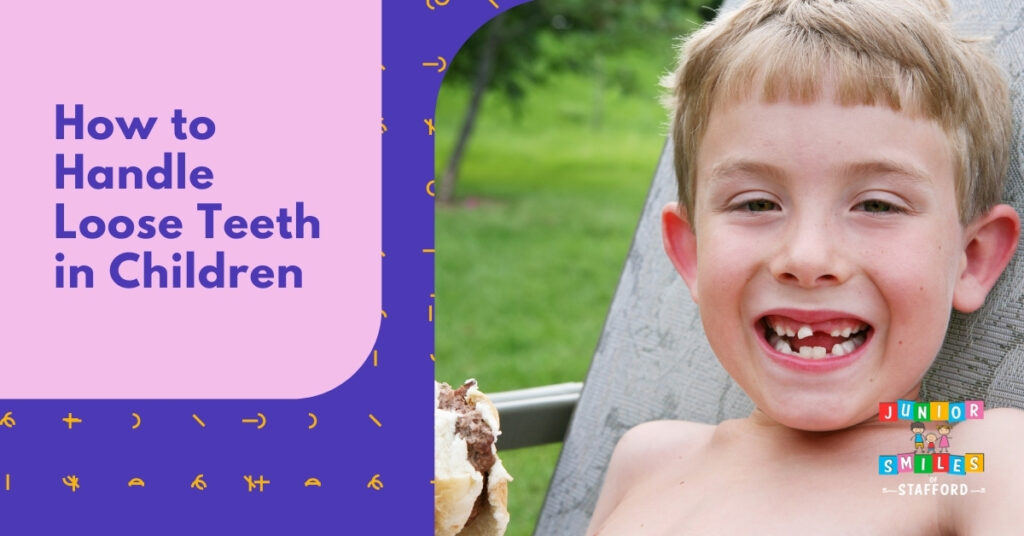Handling Loose Teeth: Is It Normal For Teeth to Wiggle?

Natural causes will take their course, and we can’t do much to prevent our children’s teeth from falling out. If we accept it and prepare ourselves appropriately, wiggling baby teeth shouldn’t be an issue.
As a parent, it is wise to be prepared to assist your child when the time comes if you’re prepared and knowledgeable about the most convenient and comfortable methods of handling loose baby teeth.
Loose teeth in kids
To get their teeth free, children generally wiggle them with their tongues or fingers, eager to tuck them under their pillows for the “tooth fairy.” If your child asks you to pull out a tooth that has already come loose, grip it firmly with a piece of tissue or gauze and twist it out of the way. In some cases, if a primary tooth is not loosening sufficiently on its own, your child’s dentist may recommend that the tooth be extracted.
Suppose your child loses their baby teeth too soon, either via decay or accident. In that case, their permanent teeth may erupt prematurely and come in crooked as a result of the restricted space available. A recent study found that 30 percent of orthodontic cases had their roots in losing baby teeth too soon.
Does a loose tooth need to be pulled?
It is preferable to allow infant teeth to fall out spontaneously to avoid stress to the gums around the tooth, which may already be irritated at the time of removal.
Discuss with your child the consequences of losing a tooth, especially if your child is in school, and make sure they understand what is expected of them. Many entertaining stories can be read to children, or you can consult the American Dental Association’s “Ask the Tooth Fairy ” for some guidance on how to start the conversation. Here are some of the highlights:
- Having a few loose teeth is very normal, and the loose tooth will fall out eventually.
- Do not be concerned about swallowing it because you will feel the sensation.
- It is fine to go to the school nurse if you’re having trouble with it coming out.
- A little blood will be there, and you can use a tissue to blot it up if you so desire.
- Keep your tooth in a tissue or a sandwich bag until you get back to your apartment.
Read More: 6 Fun Ways to Pull Out a Kid’s Tooth Without Pain
What causes baby teeth to loosen?
Teeth are maintained in place by long roots that extend deep into the jawbone and hold them in place. The roots of teeth are often two to three times longer than the actual tooth itself, indicating elongation. Moreover, several roots in some teeth (molars) enable even greater anchoring to be obtained. According to the American Dental Association, top molars have three roots, whereas bottom molars only have two roots, making for an interesting contrast. Incisors and canines have only one root: the incisor, which is the longest of the three.
Permanent teeth
The expansion of permanent tooth buds causes them to thrust themselves towards the surface of the mouth when they reach a specific size. In this migration towards the surface, the infant’s teeth’ roots are put under pressure, causing the teeth’ roots to shrink and resorb as a result of this strain. With each successive movement of the permanent tooth closer to the surface, the baby tooth’s root becomes shorter and shorter, leading the baby tooth to become progressively looser and more difficult to retain.
Baby teeth only become loose when a permanent tooth is ready to emerge from the gums, which occurs only when the permanent tooth is ready to emerge from the gums.
For the baby tooth to be pulled successfully, the baby tooth’s root must have been entirely resorbed before this could occur. To prevent root fragments from being left behind after a tooth is pulled, the pulp is removed.
Blunt force
Unless otherwise specified, the most common exception to this rule is in the event of a tooth being injured as a consequence of a fall or accident. Teeth can become loose as a result of the extreme pressure placed on them. If the injury is severe enough, the loose tooth will most likely be tightened back into place, but, in certain situations, the blunt force of the hit may cause the tooth to fall out sooner than anticipated, depending on the degree of the injury.
Tips For Relieving Your Kid’s Loose Baby Tooth Pain
The time it usually takes for a tooth to become loose and then fall out is about a few months, unless your child loses it due to blunt trauma.
When a baby tooth begins to come away for the first time, your child may not even notice and continue to eat and chew without complaint. However, as teeth become increasingly loose, biting into harder objects—for example, entire apples, corn on the cob, or carrots—may cause mild to moderate discomfort, and in some cases, substantial pain. Most of the time, this is the situation with front teeth that become loose. When the infant’s teeth come loose, chewing tougher or crunchier items may become more difficult, such as almonds, granola bars, or pretzels.
Avoid hard, crunchy foods and have your child eat on the other side.
As the roots of the baby teeth begin to resorb (or dissolve), the edges of the baby tooth root are pushed into the gums as a result of the frequent chewing and biting of the baby tooth roots. Some children may have localized discomfort as a result of this. When your child has a toothache or soreness associated with a loose baby tooth, the episodes of discomfort are most likely to occur when eating.
Brush routinely to remove plaque and bacteria.
Some youngsters will also remark that it hurts when they brush their loose baby teeth, which is understandable. To be more specific, it is not the tooth itself that is hurting, but rather the gums around the loose tooth. When there is a buildup of plaque and poor oral hygiene, the localized discomfort associated with sore gums might become more severe.
When teeth are loose, it can be tempting to avoid brushing in certain areas. However, brushing regularly is the most effective and fastest approach to making the gums feel better. This will eliminate plaque and bacteria that can cause gingivitis and gum infections. It is not necessary to brush vigorously. Be nice while still being thorough.
Over-the-counter pain medicine
Providing your child with over-the-counter pain medication such as Tylenol or Motrin for temporary relief is acceptable if they are still suffering discomfort due to a loose baby tooth.
Read More: What Do You Do When A Baby Tooth Is Loose?
What is the growth time for new permanent teeth?
As previously stated, when the permanent tooth is ready to emerge, baby teeth become loose and fall out. The permanent tooth is often visible at the level of the gums after a baby tooth has fallen out in many circumstances. Even though the adult tooth is visible when the baby tooth is lost, it may still take 6 to 12 months for the permanent tooth to develop fully.
Children with very crowded mouths may require up to a year after losing a baby tooth before their permanent teeth begin to emerge. For one thing, permanent teeth are often larger than baby teeth, and as a result, it can take longer for those larger teeth to make their way through the gums and become oriented into the proper position.
Permanent teeth may grow crooked or rotated in the mouths of youngsters who do not have enough room. The greater the space in the mouth, the longer it will take for permanent teeth to emerge and become fully functional.
Finding A Pediatric Dentist for your Child’s Loose Teeth In Stafford VA
Dr. Azar and the rest of the team at Junior Smiles Of Stafford are pediatric dental specialists. Any queries or concerns you may have about finding a pediatric dentist in Stafford, VA, or the surrounding areas will be addressed by our team. Contact Junior Smiles Of Stafford to schedule a free consultation today. Call now (540) 699-2441.

